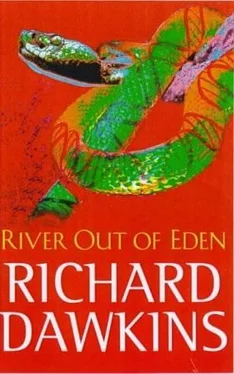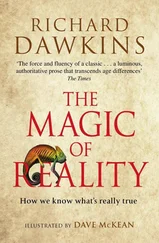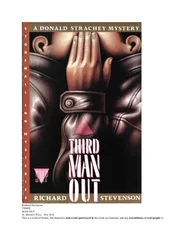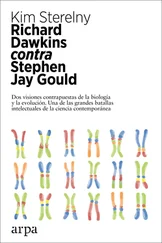Our genetic system, which is the universal system of all life on the planet, is digital to the core. With word-for-word accuracy, you could encode the whole of the New Testament in those parts of the human genome that are at present filled with “junk” DNA – that is, DNA not used, at least in the ordinary way, by the body. Every cell in your body contains the equivalent of forty-six immense data tapes, reeling off digital characters via numerous reading heads working simultaneously. In every cell, these tapes – the chromosomes – contain the same information, but the reading heads in different kinds of cells seek out different parts of the database for their own specialist purposes. That is why muscle cells are different from liver cells. There is no spirit-driven life force, no throbbing, heaving, pullulating, protoplasmic, {19} mystic jelly. Life is just bytes and bytes and bytes of digital information.
Genes are pure information – information that can be encoded, recoded and decoded, without any degradation or change of meaning. Pure information can be copied and, since it is digital information, the fidelity of the copying can be immense. DNA characters are copied with an accuracy that rivals anything modern engineers can do. They are copied down the generations, with just enough occasional errors to introduce variety. Among this variety, those coded combinations that become more numerous in the world will obviously and automatically be the ones that, when decoded and obeyed inside bodies, make those bodies take active steps to preserve and propagate those same DNA messages. We – and that means all living things – are survival machines programmed to propagate the digital database that did the programming. Darwinism is now seen to be the survival of the survivors at the level of pure, digital code.
With hindsight, it could not have been otherwise. An analog genetic system could be imagined. But we have already seen what happens to analog information when it is recopied over successive generations. It is Chinese Whispers. Boosted telephone systems, recopied tapes, photocopies of photocopies – analog signals are so vulnerable to cumulative degradation that copying cannot be sustained beyond a limited number of generations. Genes, on the other hand, can self-copy for ten million generations and scarcely degrade at all. Darwinism works only because – apart from discrete mutations, which natural selection either weeds out or preserves – the copying process is perfect. Only a digital genetic system is capable of sustaining Darwinism over eons of geological time. {20} Nineteen fifty-three, the year of the double helix, will come to be seen not only as the end of mystical and obscurantist views of life; Darwinians will see it as the year their subject went finally digital.
The river of pure digital information, majestically flowing through geological time and splitting into three billion branches, is a powerful image. But where does it leave the familiar features of life? Where does it leave bodies, hands and feet, eyes and brains and whiskers, leaves and trunks and roots? Where does it leave us and our parts? We – we animals, plants, protozoa, fungi and bacteria – are we just the banks through which rivulets of digital data flow? In one sense, yes. But there is, as I have implied, more to it than that. Genes don't only make copies of themselves, which flow on down the generations. They actually spend their time in bodies, and they influence the shape and behavior of the successive bodies in which they find themselves. Bodies are important too.
The body of, say, a polar bear is not just a pair of river-banks for a digital streamlet. It is also a machine of bear-sized complexity. All the genes of the whole population of polar bears are a collective – good companions, jostling with one another through time. But they do not spend all the time in the company of all the other members of the collective: they change partners within the set that is the collective. The collective is defined as the set of genes that can potentially meet any other genes in the collective (but no member of any of the thirty million other collectives in the world). The actual meetings always take place inside a cell in a polar bear's body. And that body is not a passive receptacle for DNA. {21}
For a start, the sheer number of cells, in every one of which is a complete set of genes, staggers the imagination: about nine hundred million million for a large male bear. If you lined up all the cells of a single polar bear in a row, the array would comfortably make the round trip from here to the moon and back. These cells are of a couple of hundred distinct types, essentially the same couple of hundred for all mammals: muscle cells, nerve cells, bone cells, skin cells and so on. Cells of any one of these distinct types are massed together to form tissues: muscle tissue, bone tissue and so on. All the different types of cells contain the genetic instructions needed to make any of the types. Only the genes appropriate to the tissue concerned are switched on. This is why cells of the different tissues are of different shapes and sizes. More interestingly, the genes switched on in the cells of a particular type cause those cells to grow their tissues into particular shapes. Bones are not shapeless masses of hard, rigid tissue. Bones have particular shapes, with hollow shafts, balls and sockets, spines and spurs. Cells are programmed, by the genes switched on inside them, to behave as if they know where they are in relation to their neighboring cells, which is how they build their tissues up into the shape of ear lobes and heart valves, eye lenses and sphincter muscles.
The complexity of an organism such as a polar bear is many-layered. The body is a complex collection of precisely shaped organs, like livers and kidneys and bones. Each organ is a complex edifice fashioned from particular tissues whose building bricks are cells, often in layers or sheets but often in solid masses too. On a much smaller scale, each cell has a highly complex interior structure of folded membranes. These {22} membranes, and the water between them, are the scene of intricate chemical reactions of very numerous distinct types. A chemical factory belonging to ICI or Union Carbide may have several hundred distinct chemical reactions going on inside it. These chemical reactions will be kept separate from one another by the walls of the flasks, tubes and so on. A living cell might have a similar number of chemical reactions going on inside it simultaneously. To some extent the membranes in a cell are like the glassware in a laboratory, but the analogy is not a good one for two reasons. First, although many of the chemical reactions go on between the membranes, a good many go on within the substance of the membranes themselves. Second, there is a more important way in which the different reactions are kept separate. Each reaction is catalyzed by its own special enzyme.
An enzyme is a very large molecule whose three-dimensional shape speeds up one particular kind of chemical reaction by providing a surface that encourages that reaction. Since what matters about biological molecules is their three-dimensional shape, we could regard an enzyme as a large machine tool, carefully jigged to turn out a production line of molecules of a particular shape. Any one cell, therefore, may have hundreds of separate chemical reactions going on inside it simultaneously and separately, on the surfaces of different enzyme molecules. Which particular chemical reactions go on in a given cell is determined by which particular kinds of enzyme molecules are present in large numbers. Each enzyme molecule, including its all-important shape, is assembled under the deterministic {23} influence of a particular gene. To be specific, the precise sequence of several hundred code letters in the gene determines, by a set of rules that are totally known (the genetic code), the sequence of amino acids in the enzyme molecule. Every enzyme molecule is a linear chain of amino acids, and every linear chain of amino acids spontaneously coils up into a unique and particular three-dimensional structure, like a knot, in which parts of the chain form cross-links with other parts of the chain. The exact three-dimensional structure of the knot is determined by the one-dimensional sequence of amino acids, and therefore by the one-dimensional sequence of code letters in the gene. And thus the chemical reactions that take place in a cell are determined by which genes are switched on.
Читать дальше












